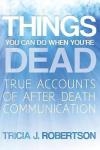
The book is aimed at the general public and those new to the field, but experienced researchers will find it of interest as well. It is divided into chapters covering: apparitions; poltergeist activity; mixed ghost/poltergeist cases; mediumship; drop-in communicators; reincarnation and healing, the last focusing on Nina Knowland and Gary Mannion. Each chapter is short and written in an accessible style. A number of the cases are famous – Enfield and the R101 for example – and some which she investigated have since become well known; but a few taken from Robertson’s case files will be new to most readers.
One that has been publicised with which she was involved with Archie Roy was that of ‘Captain Bob’, in which an airline captain, Robert Hambleton-Jones, arrived at Glasgow airport as a passenger from an overseas trip and spotted an old flying colleague, ‘Jack’, whom he had not seen for some months. The two chatted before Jack said he had to go and dashed to the end of a check-in line. The following day Bob saw an obituary for Jack and learned that he had died in Edinburgh two days before, aged only 38. Even odder, at about the same time that the two spoke at the airport, the body of an airline pilot was in the airport, being transferred from Edinburgh to be taken to Jack’s home town. Another case that has attracted a lot of interest is an instance of possible reincarnation, in which a young Glaswegian boy, Cameron Macaulay, said that he recalled a previous life on Barra, an island in the Outer Hebrides. The media attention the case has achieved includes a documentary which took him (back) to Barra. While some of Cameron’s statements about his alleged previous life could not be verified, others were.
The chapter on mediumship throws up the issue of how little we can rely on a common-sense view of the limits of the possible when evaluating extraordinary claims. In the section giving examples of the work of medium Gordon Smith, Robertson says:
‘I have also heard him inform people that they have a newspaper cutting in a handbag or wallet with a photograph of a specific person in the cutting. Often he also provides the date of the newspaper cutting and the recipient has to check to see if that is correct.’
That is certainly a remarkable feat, but no more so than the performances of mentalist Joseph Dunninger, and he was adamant that he did not possess paranormal ability or utilise confederates. It must be added that sceptics, as Robertson notes in a list of the objections that they make to paranormal claims, will dismiss a medium with ‘A magician could do the same’, but simply because what Smith did might resemble what Dunninger did, one cannot assume that they employed the same methods, and derived their information from the same source. What itdoes mean is that one cannot assume that because a medium can produce precise and startling information it has to have a paranormal source, when one cannot easily say what the limits to obtaining it by normal means are.
There is a surprising omission in the book. Robertson was involved in PRISM, Psychical Research Involving Selected Mediums, which operated from 1994-2008. It involved some of the biggest names in psychical research in their time: Roy of course, but also Arthur Ellison, Maurice Grosse, David Fontana, Ralph Noyes and Montague Keen. This association is barely mentioned, as is the work that Robertson carried out with Roy which they reported in three articles in the SPR’s Journal. They investigated twenty-seven mediums over a period of five years, examining the mediums’ statements statistically to see if they had provided information specific to sitters, or if it could apply to anyone. This mammoth undertaking would have been worth a much lengthier discussion. It is also worth pointing out that the Maxwell Park case, which was investigated in part by Archie Roy, did not actually take place in Maxwell Park in south Glasgow, but at Balornock on the far side of the city. Roy had muddied the waters in A Sense of Something Strange (1990) by omitting to mention that Maxwell Park was a pseudonym, and this mislocation was perpetuated in the literature until corrected by Geoff Holder in his Poltergeist over Scotland.
These minor caveats aside, the book contains case studies which show that such experiences are commoner than one might suppose. Robertson has examined them with a great deal of empathy, describing ordinary people coping in strange situations. At a time when psychical research seems in danger of losing its way, she has shown that useful investigations can still be done and valuable data collected.

